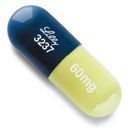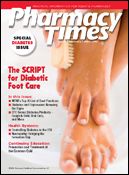A Closer Look at New FDA Actions: Cymbalta
Dr. Holmberg is a freelance clinical writer based in Phoenix, Arizona.
Eli Lilly's Cymbalta

. The FDA has approved Cymbalta (duloxetine HCl) for use in adult patients for the management of fibromyalgia. Cymbalta is marketed by Eli Lilly and previously was approved for use in patients with major depressive disorder, generalized anxiety disorder, and diabetic peripheral neuropathic pain.1 It is the second agent to receive FDA approval for the management of fibromyalgia.2
Fibromyalgia is a chronic pain syndrome that affects an estimated 2% of Americans. Patients with fibromyalgia often experience widespread pain and stiffness in their joints and muscles. The diagnosis of fibromyalgia usually occurs between ages 20 and 50 and is more prevalent in women than in men. Per the American College of Rheumatology, the criteria for a diagnosis of fibromyalgia include at least 3 months of diffuse pain that include all 4 limbs and the trunk and at least mild tenderness in 11 or more of the 18 specified tender spots. Approximately 30% of patients with fibromyalgia will experience depression or anxiety during their lifetime.3,4
Although the cause of fibromyalgia is unknown, researchers believe it may be influenced by changes in the chemistry of the spinal cord and brain, genetics, and stress.2
Mechanism of Action
Cymbalta is a selective serotonin and norepinephrine reuptake inhibitor (SSNRI). Its exact mechanism of action is unknown but believed to be related to its serotonergic and noradrenergic effects.1
Clinical Trials
The role of Cymbalta in fibromyalgia was studied in 2 randomized, doubleblind, placebo-controlled, fixed-dose trials in adult patients with a diagnosis of fibromyalgia that was consistent with the criteria established by the American College of Rheumatology. Study 1 compared Cymbalta 60 mg daily or 60 mg twice daily (120 mg daily) to placebo in 354 women for 3 months. Study 2 evaluated Cymbalta 60 mg daily or 120 mg daily (as a single dose) to placebo in a total of 520 men and women for 6 months. Both studies found a significant decrease in pain scores from baseline in patients using either 60 mg or 120 mg Cymbalta daily; however, no significant difference in efficacy was reported between the 60- and 120-mg doses despite an increase in adverse drug reactions and early drug discontinuation in the 120-mg dose.1
Dosing
For the management of fibromyalgia, Cymbalta should be dosed as 30 mg once daily for a week and 60 mg daily thereafter.1
Contraindications, Warnings, and Precautions
Treatment with Cymbalta is contraindicated in patients who are using or have recently used a monoamine oxidase inhibitor or in patients with uncontrolled narrow-angle glaucoma.
Cymbalta carries a boxed warning regarding the association of increased suicidality with the use of antidepressant agents. Hepatotoxicity has occurred in patients using Cymbalta. Its use should be avoided in patients consuming substantial amounts of alcohol or with chronic liver disease. Cymbalta should not be used in patients with a creatinine clearance <30 ml/min. Orthostatic hypotension, syncope, serotonin syndrome, abnormal bleeding, and hyponatremia have been reported in patients using Cymbalta. Cymbalta may activate mania or hypomania. Cymbalta should be used cautiously in patients with seizure disorder, controlled narrow-angle glaucoma, and conditions that slow gastric emptying. Cymbalta may be associated with urinary hesitation and resistance. Cymbalta should not be used during breast-feeding. and is a Pregnancy Category C drug. Cymbalta should not be used in patients under age 18.1
Adverse Events
The most common adverse reactions to Cymbalta were nausea, dry mouth, constipation, somnolence, hyperhidrosis, and decreased appetite.1
Drug Interactions
Cymbalta is metabolized by both CYP1A2 and CYP2D6 and is a moderate inhibitor of CYP2D6. Potent inhibitors of CYP2D6 may increase the concentration of Cymbalta. Concomitant treatment with potent inhibitors of CYP1A2 and/or monoamine oxidase inhibitors should be avoided.
Concurrent use of Cymbalta with other drugs that may affect serotonergic pathways should be avoided, as the combination may increase the risk of serotonin syndrome. Examples of drugs with serotonergic effects include SSRIs, SNRIs, tryptophan, triptans, linezolid, lithium, tramadol, and St. John's Wort.1
References
- Cymbalta [package insert]. Indianapolis, IN: Eli Lilly and Company; 2008. pi.lilly.com/us/cymbalta-pi.pdf. Accessed July 2008.
- FDA approves Cymbalta for the management of fibromyalgia [press release]. newsroom.lilly.com/ReleaseDetail.cfm?ReleaseID=316740. Accessed July 2008.
- Abeles AM, Pillinger MH, Solitar BM, Abeles M. Narrative review: the pathophysiology of fibromyalgia. Ann Intern Med. 2007;146:726-34.
- Nampiaparampil DE, Shmerling RH. A review of fibromyalgia. Am J Manag Care. 2004;10:794-800.

